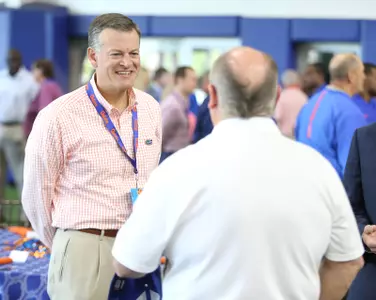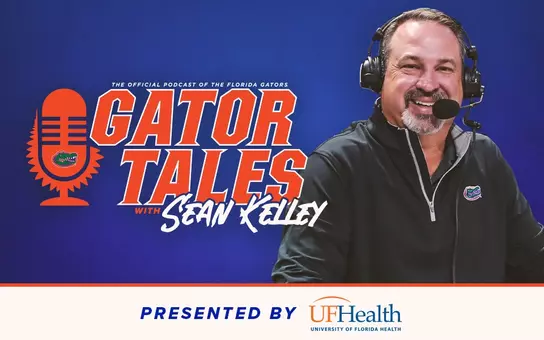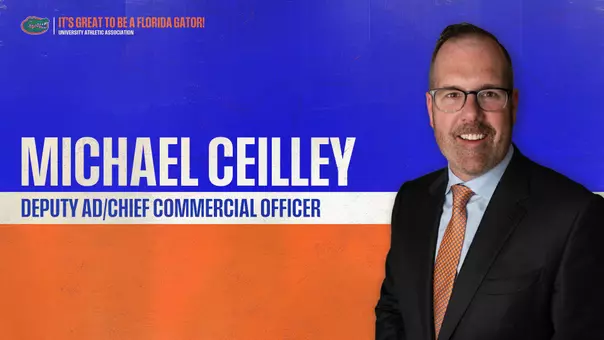
Gators Athletic Director Scott Stricklin has spent much of his first 16 months on the job to finalize phases 2 and 3 of Florida's Facilities Master Plan. (Photo: Tim Casey/UAA Communications)
Stricklin Reshaped Course for Facilities Master Plan
Friday, March 23, 2018 | General, Scott Carter
UF Athletic Director Scott Stricklin assumed a large task right away when he took over the program, revamping the plans for a proposed major facilities project.
GAINESVILLE, Fla. – In the early stages of Scott Stricklin's tenure as Florida's athletic director, he would sometimes joke that he was in the middle of a wardrobe makeover as he transitioned from Mississippi State colors to the orange and blue of the Gators.
Nearly 17 months later, Stricklin is directing another type of transformation. This one is an extreme makeover of the Gators' athletic facilities as the University Athletic Association announced Friday phases 2 and 3 of its Facilities Master Plan.
Continuing a movement that started near the end of former Gators Athletic Director Jeremy Foley's 25-year run in charge of the department with the $65 million renovation of the O'Connell Center, construction of an indoor practice facility for football and the Otis Hawkins Center for Academic and Personal Excellence at Farrior Hall, the UAA is ready to tackle a timeline for major facility projects for softball, baseball and football.
Stricklin's fingerprints are all over each venue.
"It's been a real focus,'' Stricklin said. "When you have a program as comprehensive as we have here at Florida, with over 500 athletes, over 300 staff, and obviously as many fans and alumni and students as we have, you need to make sure your infrastructure is supporting those individuals in the right way."
Stricklin's most high-profile move since taking over as UF's athletic director on Nov. 1, 2016, is the hiring of football coach Dan Mullen. The coaching change from Jim McElwain to interim head coach Randy Shannon and, finally, to the signing of Mullen moved at a brisk pace.
The Facilities Master Plan has taken longer to devise and required significant fundraising by Stricklin and Gator Boosters, a task that continues.
The three facility upgrades will cost approximately $126 million -- $65 million for a new stand-along football facility, $50 million for a new baseball stadium, and $11 million for a modernization and revamping of the Katie Seashole Pressly softball stadium.
Getting them right has been at the forefront for Stricklin, a longtime college administrator who has worked at public and private schools over the past three decades and been involved in other major facility ventures.
"You want to make sure you're not doing something just to do something,'' Stricklin said. "You want to make sure it's going to have a long-term impact when you invest the kind of money that is about to be invested that it's done right the first time and future generations of Gators get to benefit from it."
In Florida's case, the lack of an abundance of open land on campus slowed the progress.
The UAA released an original Facilities Master Plan in September 2016, highlighted by plans to build a new stand-alone football facility off NW 2nd Ave. adjacent to Percy Beard Track and the football team's Sanders Practice Fields. The plan also included $30 million to renovate McKethan Stadium for baseball and additional funds to revamp the softball stadium.
However, hurdles quickly surfaced with the location of the proposed football facility.
Stricklin went to work on trying to find solutions.
"There were going to be issues there we could not solve based on the footprint,'' he said. "At the same time, we started looking at baseball. It became just cosmetic and it wasn't really going to significantly change the experience. That's a lot of money to not get a real positive result on. That led to if we could get some new land to do baseball, that opened up a lot. It doesn't impact track in a negative way as the original plan. It made more sense. It's more expensive, but I think in the long-term it's going to be a much better investment for our infrastructure."
The baseball stadium is set to utilize 13.6 acres of land previously occupied by the University of Florida Institute of Food and Agriculture Sciences (UF/IFAS). The move will open up the land now occupied by McKethan Stadium to build the stand-alone football facility.
A lifelong baseball fan who spearheaded the planning of Mississippi State's newly revamped baseball stadium, Stricklin views the latest plan as a win-win for fans, student-athletes and the football and baseball programs.
Each venue features a special Florida touch.
"You want to make sure you do things that are distinctive for where you are," he said. "It totally changes the [baseball] experience. I'm convinced that our fan base enjoys college baseball and it's my belief that our current facility is not as inviting as what we have an opportunity to do. People are going to be surprised by how much support there is for Gator baseball."
Meanwhile, the stand-alone football facility offers more efficiency for the program than the current setup in Ben Hill Griffin Stadium.
While the team will maintain a game-day locker room at The Swamp, once the new facility is built, Stricklin envisions major renovations to the iconic home of the UF football team, including the addition of premium spaces and amenities for fans.
"There's going to be more phases down the road because eventually we're going to touch all of our sports, and we're also going to touch Ben Hill Griffin Stadium in a significant way,'' he said.
The Gators have been questioned for the better part of a decade on whether they were falling behind the rest of the Southeastern Conference in facilities. Friday's announcement is a major development in bridging the past to the future.
The football facility is the costliest and only project that doesn't impact the fan experience in a major way. However, Stricklin saw why the previous administration made plans to build the facility once he settled at UF and began envisioning the future of the department under his direction.
"We'll have the opportunity to really provide something that is going to help our football players develop,'' he said. "What we have is obviously adequate, but it's not at the level of what we compete with and it's as efficient. No one is using facilities as a reason why we're not where we want to be. When you talk about putting infrastructure in place for the long-term benefit of your program, I think this is a critical piece."
A primary emphasis for Stricklin as the projects take shape is to continue to raise money. To help the cause, he is confident the plan unveiled Friday is one that will excite the fan base and ramp up support.
In some ways, Stricklin's tenure at UF feels as though it's just starting.
"These next two phases kind of set the stage for some really significant things that could come next,'' he said. "You always have to have a road map of where you are going, and if you don't, you can get real stagnant really quick and you find yourself not where you need to be from a facility standpoint. Whether we like it or not, facilities say a lot about where your commitment is to student-athletes and to fans."
Nearly 17 months later, Stricklin is directing another type of transformation. This one is an extreme makeover of the Gators' athletic facilities as the University Athletic Association announced Friday phases 2 and 3 of its Facilities Master Plan.
Continuing a movement that started near the end of former Gators Athletic Director Jeremy Foley's 25-year run in charge of the department with the $65 million renovation of the O'Connell Center, construction of an indoor practice facility for football and the Otis Hawkins Center for Academic and Personal Excellence at Farrior Hall, the UAA is ready to tackle a timeline for major facility projects for softball, baseball and football.
Stricklin's fingerprints are all over each venue.
"It's been a real focus,'' Stricklin said. "When you have a program as comprehensive as we have here at Florida, with over 500 athletes, over 300 staff, and obviously as many fans and alumni and students as we have, you need to make sure your infrastructure is supporting those individuals in the right way."
Stricklin's most high-profile move since taking over as UF's athletic director on Nov. 1, 2016, is the hiring of football coach Dan Mullen. The coaching change from Jim McElwain to interim head coach Randy Shannon and, finally, to the signing of Mullen moved at a brisk pace.
The Facilities Master Plan has taken longer to devise and required significant fundraising by Stricklin and Gator Boosters, a task that continues.
The three facility upgrades will cost approximately $126 million -- $65 million for a new stand-along football facility, $50 million for a new baseball stadium, and $11 million for a modernization and revamping of the Katie Seashole Pressly softball stadium.
We're announcing new facilities for @GatorsFB and @GatorsBB, plus upgrades for @GatorsSB.
— Florida Gators (@FloridaGators) March 23, 2018
All the details - click here: https://t.co/tbgeiu4BJU
Getting them right has been at the forefront for Stricklin, a longtime college administrator who has worked at public and private schools over the past three decades and been involved in other major facility ventures.
"You want to make sure you're not doing something just to do something,'' Stricklin said. "You want to make sure it's going to have a long-term impact when you invest the kind of money that is about to be invested that it's done right the first time and future generations of Gators get to benefit from it."
In Florida's case, the lack of an abundance of open land on campus slowed the progress.
The UAA released an original Facilities Master Plan in September 2016, highlighted by plans to build a new stand-alone football facility off NW 2nd Ave. adjacent to Percy Beard Track and the football team's Sanders Practice Fields. The plan also included $30 million to renovate McKethan Stadium for baseball and additional funds to revamp the softball stadium.
However, hurdles quickly surfaced with the location of the proposed football facility.
Stricklin went to work on trying to find solutions.
"There were going to be issues there we could not solve based on the footprint,'' he said. "At the same time, we started looking at baseball. It became just cosmetic and it wasn't really going to significantly change the experience. That's a lot of money to not get a real positive result on. That led to if we could get some new land to do baseball, that opened up a lot. It doesn't impact track in a negative way as the original plan. It made more sense. It's more expensive, but I think in the long-term it's going to be a much better investment for our infrastructure."
The baseball stadium is set to utilize 13.6 acres of land previously occupied by the University of Florida Institute of Food and Agriculture Sciences (UF/IFAS). The move will open up the land now occupied by McKethan Stadium to build the stand-alone football facility.
A lifelong baseball fan who spearheaded the planning of Mississippi State's newly revamped baseball stadium, Stricklin views the latest plan as a win-win for fans, student-athletes and the football and baseball programs.
Each venue features a special Florida touch.
"You want to make sure you do things that are distinctive for where you are," he said. "It totally changes the [baseball] experience. I'm convinced that our fan base enjoys college baseball and it's my belief that our current facility is not as inviting as what we have an opportunity to do. People are going to be surprised by how much support there is for Gator baseball."
Meanwhile, the stand-alone football facility offers more efficiency for the program than the current setup in Ben Hill Griffin Stadium.
While the team will maintain a game-day locker room at The Swamp, once the new facility is built, Stricklin envisions major renovations to the iconic home of the UF football team, including the addition of premium spaces and amenities for fans.
"There's going to be more phases down the road because eventually we're going to touch all of our sports, and we're also going to touch Ben Hill Griffin Stadium in a significant way,'' he said.
The Gators have been questioned for the better part of a decade on whether they were falling behind the rest of the Southeastern Conference in facilities. Friday's announcement is a major development in bridging the past to the future.
The football facility is the costliest and only project that doesn't impact the fan experience in a major way. However, Stricklin saw why the previous administration made plans to build the facility once he settled at UF and began envisioning the future of the department under his direction.
"We'll have the opportunity to really provide something that is going to help our football players develop,'' he said. "What we have is obviously adequate, but it's not at the level of what we compete with and it's as efficient. No one is using facilities as a reason why we're not where we want to be. When you talk about putting infrastructure in place for the long-term benefit of your program, I think this is a critical piece."
A primary emphasis for Stricklin as the projects take shape is to continue to raise money. To help the cause, he is confident the plan unveiled Friday is one that will excite the fan base and ramp up support.
In some ways, Stricklin's tenure at UF feels as though it's just starting.
"These next two phases kind of set the stage for some really significant things that could come next,'' he said. "You always have to have a road map of where you are going, and if you don't, you can get real stagnant really quick and you find yourself not where you need to be from a facility standpoint. Whether we like it or not, facilities say a lot about where your commitment is to student-athletes and to fans."
Florida Women's Basketball | Postgame Press Conference | Samford
Friday, November 14
Florida Volleyball | Jordan Byrd GETS UP for the BLOCK ✋
Thursday, November 13
Florida Men's Basketball | Rueben Chinyelu and Thomas Haugh Post Double-Doubles
Thursday, November 13
Florida Football | Interim Head Coach Billy Gonzales Media Availability | Ole Miss
Wednesday, November 12








